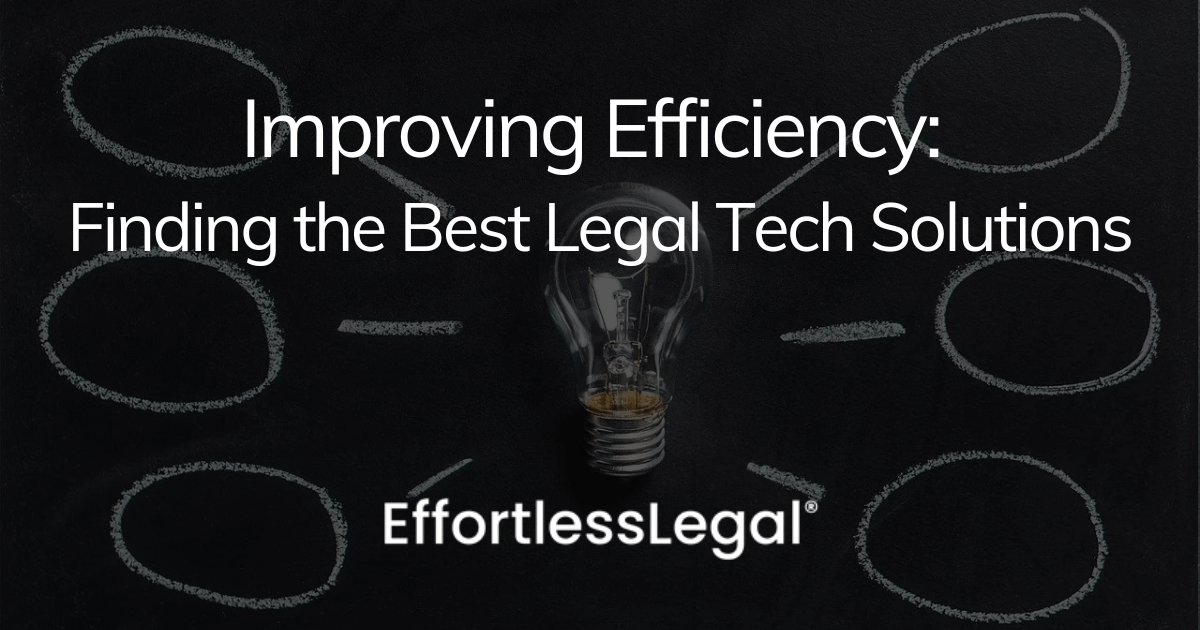Improving Efficiency: Finding the Best Legal Tech Solutions

Improving efficiency is an ever-important but never-ending aspect of maintaining and growing any business, including law firms. Having a finger on the pulse of technological advancement keeps a firm “in the know” of applications that can make their jobs easier, reduce overhead, and make their clients happier.
Because only around 30 percent of law firms employ a technology specialist with the primary goal of keeping the firm at the cutting edge of innovations, the task of staying up to date with the best solutions often falls on lawyers themselves. In fact, most states have adopted ABA Model Rules of Professional Conduct Rule 1.1’s duty of technology competence, making lawyers directly responsible for keeping up to speed.
Nevertheless, adapting to relevant technology is one of the biggest challenges facing law firms today.
The problem isn’t a lack of options. For example, Law Geex reported roughly $1 billion in investments in new legal technologies during the 2018 year. Similarly, Bloomberg Law reports that investments in legal technologies exceeded $400 million in the first quarter of 2019 alone.
The actual issue is finding and implementing legal tech solutions that are best suited to the needs of a specific law firm or practice group. Knowing what to look for is key.
Cloud-based Applications
The internet and the cloud have made it possible to work from virtually anywhere with the right equipment. Not being restricted to an office provides for greater flexibility and the potential for even more billable hours.
Cloud-based legal software is an efficient way to accomplish this. Using the cloud, everyone in a firm has access to the same information at the same time. Any changes are made in real-time to eliminate confusion or redundancy. Additionally, cloud-based legal software can integrate with the processes of other systems, like billing, to create even more efficiency.
Practice management software like Clio, RocketMatter, Actionstep, and PracticePanther have found ways to digitally centralize pertinent legal information to allow employees to quickly and easily access what they need and streamline the performance of everyday tasks.
Automation
The practice of law is filled with repetitive and tedious tasks. In addition, necessary operations like monthly billing consume significant amounts of time, but technically have nothing to do with the actual practice of law, and are unbillable.
Technology has advanced to the point where most of these tasks can be aided, if not done entirely, using automation. In fact, according to the McKinsey Global Institute, almost a quarter of an attorney’s job can be automated. Fortunately, the tasks that can be automated are often the most tedious and time-consuming.
Automating time and expense entry, the client intake process, document review, and even legal research have all been shown to both cut down on the time it takes to complete the tasks, as well as increasing the accuracy with which they are accomplished.
Billing is a good example. Automated billing applications will effectively do the work for you. Moreover, these applications can recognize patterns in your data and help you make resource allocation decisions to assist in growing your business.
Other legal tech options like legal research automation are a bit more nuanced. Two examples of advanced legal research applications that use Artificial Intelligence (AI) to find the most relevant cases and other authorities are CaseText and ROSS Intelligence. Automating legal research can help lawyers save time and allow them to focus on more sophisticated aspects of their work.
Using Data
Law firms and legal departments alike store large amounts of data that could be useful in improving the accuracy of their decision-making, and in increasing efficiency.
In fact, law firms saw a 66 percent increase in revenue from the implementation of better data mining, according to Accudata.
Likewise, a recent study by Thomson Reuters demonstrated that many in-house legal departments are implementing myriad forms of data analysis, “including everything from ;analyzing trends and managing costs’ and ‘pattern recognition features and data analysis deep dives”’ to ‘predicting future budgets, future number of issues, and explaining reason for data.’”
Data shows a law firm or legal department what is working in their best interest and what could be holding them back. It helps chart a more productive way forward using empirical information that is often more reliable than gut feelings.
Conclusion
Cloud-based applications allow lawyers to work and collaborate with each other from anywhere with an internet connection without missing a beat.
In addition, automating tedious tasks allows them to be done more efficiently. Automation is not only making attorneys’ jobs easier, but it is also helping them be more accurate and efficient. As an added bonus, automated processes tend to add a greater level of transparency that modern clients appreciate.
Extrapolating best practices from data is a scientific way to make sure a firm learns both from its successes and failures.
Focusing on these areas is only the tip of the iceberg when it comes to technologically optimizing your firm. However, they are important places to start.


